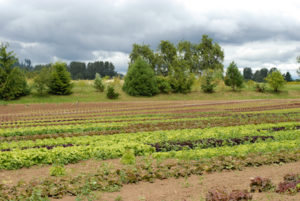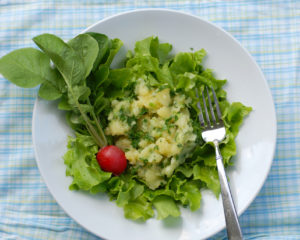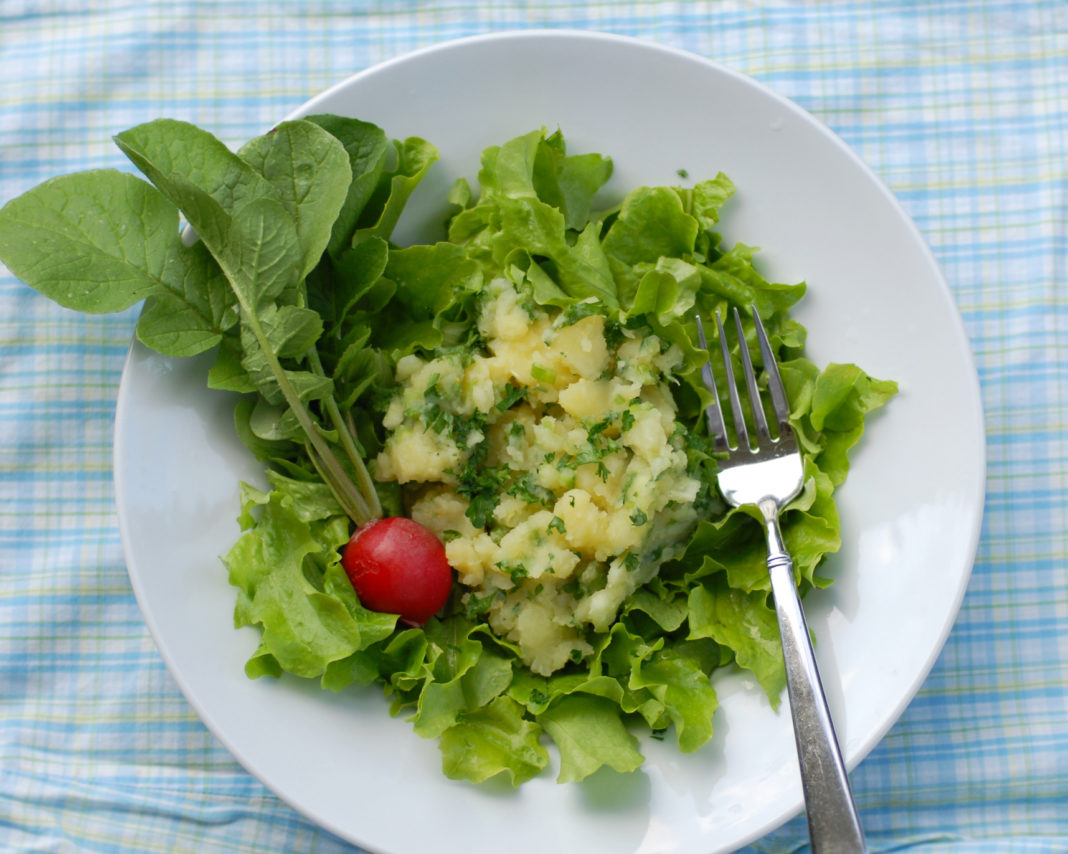Spring in the Northwest means it’s time to start thinking about food – more specifically, where our fresh food will come from and how we can keep our environmental footprint small, while maximizing our access. In the last of our four-article series featuring the work of the South Sound Food System Network (SSFSN), several members offer their expertise on how to do just that, namely by buying direct from farmers, making choices that help boost our soil health in the region and reducing our food waste.
The Environmental Impact of Local Food Production
Food production creates many jobs in our region and has additional environmental benefits when organic and sustainable practices are used. According to Stephen Bramwell, Extension Director and Agriculture Faculty for WSU Thurston County Extension: “Farmland sequesters carbon, captures, stores and purifies rainwater in many cases, and provides other ecosystem service such as pollinator, bird and other wildlife habitat, and draws visitors to the region interested in farming and good food.”
“American and European farmers started growing food in the region around the time the first wave of settlers arrived in the mid-19th century. There are still several Thurston County farms and families that have roots in this mid-to-late 19th century period,” adds Robin Buckingham, Natural Resource Specialist with the Thurston Conservation District.

Stephen and Robin say there are currently between 68,000 and 76,000 acres of farmland in Thurston County, which is comprised of woodland, pasture, farmstead facilities, ponds and cropland. Farmland accounts for about 1 out of every 7 acres in the county.
Both Robin and Stephen believe the key to local food production making a positive impact on environmental sustainability comes down to consumer choices. If we don’t buy our food directly from local farmers through CSAs, farmers, markets, and stores and restaurants that prioritize using local food, most of our food will inevitably come from out of the area. This increases the carbon footprint it takes to get the food from the growers to our kitchen tables and decreases the amount of farmland being used to offset the negative impacts of urban growth.
“With the median age of farmers at 57 years old and 75 percent of farmland within 3 miles of developing urban areas, the pressures on Thurston County’s farmland are great,” says Robin. “American Farmland Trust’s 2012 Losing Ground report estimates that Thurston County has lost over 100,000 acres of farmland since 1950. Projections of population growth by Thurston Regional Planning Council indicate a 47% increase by 2040. This combination of decreasing farmland, aging of the farmer population, and increasing development from population growth create a pressing need to protect the economic, social and environmental benefits of the farmland we do have – while we still have it.”
However, despite the decrease in farmland, it’s not only individuals and small farms leading the way toward a more sustainable future. It’s important to note that many nurseries, dairies, poultry farms, greenhouses and aquaculture farms are making meaningful contributions to environmental sustainability, even if they don’t primarily engage in local food production. Informed consumers willing to pay for the environmental services these companies do is the key
The Importance of Soil Fertility
If, like me, you wonder why soil fertility really matters when it comes to growing food and why we can’t grow food in just any old dirt, Stephen has a great answer for us. He says, “Crops can be grown in just any old dirt…What separates healthy soil from depleted soil is that soil does more than simply grow plants. When healthy, it can store carbon, purify water as it percolates to the water table, store water in great quantities (like a sponge), remove toxins when roadways are channeled through rain gardens in urban environments, recycle wastes such as manure and urban yard debris into valuable nutrients, host a dazzling array of soil organisms, and supply nutrients in available form for plants and soil organisms.”

If you’re growing food at home and wish to grow directly in the ground, rather than in pots or raised beds, but your soil is less than ideal, there are things you can do to help build soil health.
Stephen says, “The key practices for enriching soil are to grow cover crops, add compost, mulch to keep the soil surface protected, and where possible practice a rotation between annual crops and perennial crops.”
The Impacts of Food Waste
The environmental impacts of food production don’t end with shopping locally. Decreasing food waste is one of the biggest ways we can minimize our impact. According to Peter Guttchen, who has been working in waste reduction for the county and state for the last 10 years, “Globally we waste 1.3 billion tons of food each year. Wasting food takes an enormous toll on our environment. When it rots in a landfill, food quickly generates methane, a potent greenhouse gas. If food waste was a country, it would be the third largest emitter of greenhouse gases after the United States and China.”
He adds, “In Thurston County, food is by far the largest single item in our trash. In 2014, almost 28,000 tons or 17 percent by weight of what we threw away locally was food and an estimated 43 percent of that food (more than 12,500 tons) was edible at some point before it was discarded and shipped 240 miles to be buried in a mega-landfill in southeastern Washington. All this, while 1 in 6 households and 1 in 5 children in our communities struggle with hunger.”
Fortunately, Peter has some tips for us on how we can do our part to reduce food waste by shopping, prepping, storing and eating “SMART” (Saving Money and Reducing Trash):
- Shop SMART: Buy only what you need. Check your freezer, fridge and cupboards first so you don’t buy stuff you already have. Shop with a list and stick to it and shop with meals in mind.
- Prep SMART: Prepare it now, eat it later. Focus on produce! It’s the food we waste most. Slice and dice it when you get home from the store.
- Store SMART: Keep it fresh. Store foods in clear containers. Date and label foods in the freezer. Learn what fruits and veggies want to be in the fridge – or not.
- Eat SMART: Use what you buy. Understand your labels – most foods stay fresh far longer than their sell by, use by and best before dates. Create an “eat first” bin or section in your fridge for the food that needs to be used first.

Stephen adds that if you do end up with food that has gone to waste, you should add those and any food scraps to your organics bin, for pick-up by either the city or county waste services. If you want to compost at home, in order to build the soil health of your home garden, he says “a worm bin is the easiest way to recycle kitchen wastes, while physically preventing pests like rats or raccoons from making a mess.” He adds that: “Chickens are a highly efficient way to recycle food waste. No home has food waste that has chickens!”
Peter says you can also help by “rescuing food from grocery stores, restaurants, schools, and other local businesses and institutions. Local food banks, food pantries and community meal programs in Thurston County are now participating in a program call Thurston Food Rescue. In 2016, they recovered more 470 tons of perishable, nutrient-dense food to serve to people in need. They need your help to solicit new food donors and to prepare meals and distribute food. To find out how you can participate, contact the Thurston County Food Bank at 360-352-8957, extension 102.”
A Quick Report Back on the 2017 Food Summit
On October 20-21, 2017, 334 attendees participated in SSFSN’s South Sound Food Summit and Tasting Salon, which brings out dozens of food and beverage vendors offering everything from honeycomb to hard cider goat cheese to gelato, as well as a series of breakout sessions. Each breakout session will be 75 minutes long and include 300-100 attendees. In addition to individual attendees, delegates from partner organizations attended the summit on Saturday, including about 40 students from Evergreen’s Seeds of Change program, and about 80 participants from Family Education & Support Services, Enterprise for Equity, SNAP Ed, GRuB, St Martin’s University, SPSCC, Family Support Center, Mason Matters, Yelm 4H, Tumwater FRESH, Senior Services for South Sound and Olympia Community Garden. This represented the most diverse and representative group that local food system organizing has seen yet. SSFSN sees this as a great beginning and recognizes that there’s still much work to be done when it comes to bringing more stakeholders to the table for these conversations. Visit The South Sound Food System Network for more information or to offer suggestions, feedback, and requests.
Sponsored



















































